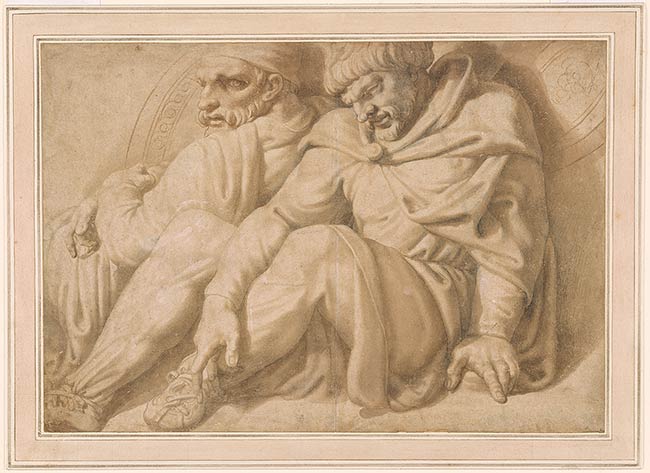
Previously ascribed to Daniele da Volterra, this drawing was recognized as the work of Pellegrino Tibaldi by John Gere,1 who related it to the lost facade of Francesco Formento’s palace at Vicolo Savelli in Rome, which the artist most likely painted in 1549–50 before returning to Bologna.2 The previous attribution to Daniele attests to the association of this work with the figural vocabulary of michelangelismo, which both Daniele and Tibaldi zealously embraced during the mid-1540s. In fact, the emphasis on the massive, muscular figures of the two captives confined within a tiny space immediately brings to mind Michelangelo’s paintings for the Sistine ceiling, particularly his celebrated ignudi. Tibaldi’s devotion to the art of Michelangelo developed during his stay in the Eternal City, to which he moved after receiving his initial training in Bologna.
After collaborating with Perino del Vaga on the decoration of the Sala Paolina in Castel Sant’Angelo (1546–47), Tibaldi worked with Daniele da Volterra, Michelangelo’s closest friend and follower, in the chapel of Lucrezia Della Rovere in Trinità dei Monti (1548–49). The collaboration with Daniele in particular proved crucial for Tibaldi’s stylistic development under the immediate inspiration of Michelangelo’s art. This is displayed on the grandest imaginable scale in the Adoration of the Magi at the Galleria Borghese, Rome,3 as well as in the lost frescoes of the facade of Francesco Formento’s palace, executed most likely in the same year as the Borghese painting but possibly shortly afterward.
The lost decoration of the facade is recorded in an engraving by Enrico Maccari.4 Most probably executed in chiaroscuro, the decoration included, at top, a frieze with griffins and armor as war trophies and, in the center, a large scene depicting Ceres on her chariot drawn by dragons, and a man mounting a chariot drawn by horses. In the lower section, Tibaldi included two allegorical figures, Prudence and Justice, flanked by satyr herms.5 Finally, squeezed between the windows of the upper floors of the building were reclining figures surrounded by shields representing conquered provinces. Given the presence of the armor in the Morgan drawing, and considering that one of the two captives in the sheet appears in a similar pose to that of the figure visible at left in Maccari’s print, the sheet has been rightly considered to have been a prima idea for the facade frescoes that was eventually discarded by the artist.
The two figures depicted in the drawing are immediately recognizable as barbarians. They wear trousers, the most distinctive garment of the non-Roman populations, secured to their ankles by the laces of their sandals. The disproportionately large hands, lumpy noses, deeply shadowed, drooping eyes, and dense beards and mustaches equally contribute to the brutal appearance of the captives, whose faces are almost distorted by their grotesque features. These attributes likely reflect Tibaldi’s training in Bologna, where the local artistic tradition always exhibited a certain inclination for the extravagant and the bizarre. Certain features of the Morgan drawing reappear in most of the artist’s painted and drawn creations, such as the Study of a Male Head, at the Louvre,6 and Four Grotesque Masks, also at the Morgan (1979.9).
During the drawing process, Tibaldi seems to have devoted much attention to the sculptural rendering of the two monumental bodies of the captives, which emerge from the surface of the sheet like sculptures in a bas-relief. This impressive tridimensional solidity was obtained by the attentive application of black chalk over brown wash in meticulous, tiny strokes. The use of cross and parallel hatching reveals Tibaldi’s profound debt to Daniele da Volterra’s drawing style (for which see 2001.39) and demonstrates the artist’s admiration for a Michelangelesque plasticity, for which the artist would later be identified as a “Bolognese Michelangelo.”7
—MSB
Footnotes:
- See Gere 1971, 82.
- Francesco Formento was a textile merchant from Como, near Milan, who also possessed a collection of paintings. See Härb in Ottawa 2009, 214n3. The paintings of the facade are recorded by Vasari in his Vite (Vasari 1996, 2:776; Vasari 1878–85, 7:417): “In the house of Francesco Formento, between the Strada del Pellegrino and the Parione, he painted in a courtyard a facade and two figures besides.” On Pellegrino Tibaldi’s paintings for the palace, see Winkelmann in Fortunati Pietrantonio 1986, 2:480, and Romani 1990, 54–55.
- Galleria Borghese, Rome. The painting is signed and dated 1549.
- The print is reproduced in Maccari’s Graffiti e chiaroscuri esistenti nell’esterno delle case riprodotti in rame. See Maccari 1876, pl. 37.
- A preparatory drawing for the figure of Prudence is in Kupferstichkabinett, Berlin, KdZ 15456; see Ottawa 2009, no. 53.
- Musée du Louvre, Paris, inv. 22363.
- The annotation is by Sebastiano Resta (Altro Michelangelo Bolognese), transcribed in Bora 1976, 279.
Watermark: none visible through lining.
Formerly attributed to Daniele da Volterra.
Daniele, da Volterra, approximately 1509-1566, Formerly attributed to.
Argyll, John Campbell, Duke of, approximately 1693-1770, former owner.
Richardson, Jonathan, 1665-1745, former owner.
Murray, Charles Fairfax, 1849-1919, former owner.
Morgan, J. Pierpont (John Pierpont), 1837-1913, former owner.
Morgan, J. P. (John Pierpont), 1867-1943, former owner.
Selected references: Fairfax Murray 1905-12, 1: no. 37; Gere 1971, 82; Dibbits 1998, 30.
Rhoda Eitel-Porter and and John Marciari, Italian Renaissance Drawings at the Morgan Library & Museum, New York, 2019, no. 107.
Charles Fairfax Murray, Collection of Drawings by the Old Masters formed by C. Fairfax Murray (J. Pierpont Morgan Collection), 4 vols., London, 1905-1912, I, no. 37, repr.
John A. Gere, Il manierismo a Roma, Milan, 1971, p. 82, repr. pl. IX.
Taco D.W. Dibbits, "Pellegrino Tibaldi in Ancona: Two new drawings in red chalk," Apollo, vol. 148, no. 441, November 1998, p. 30.
